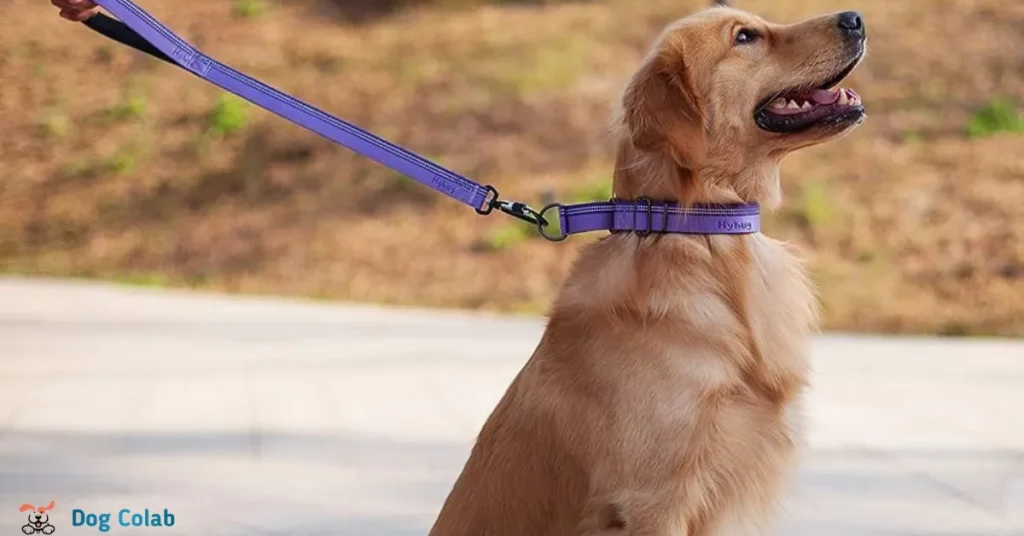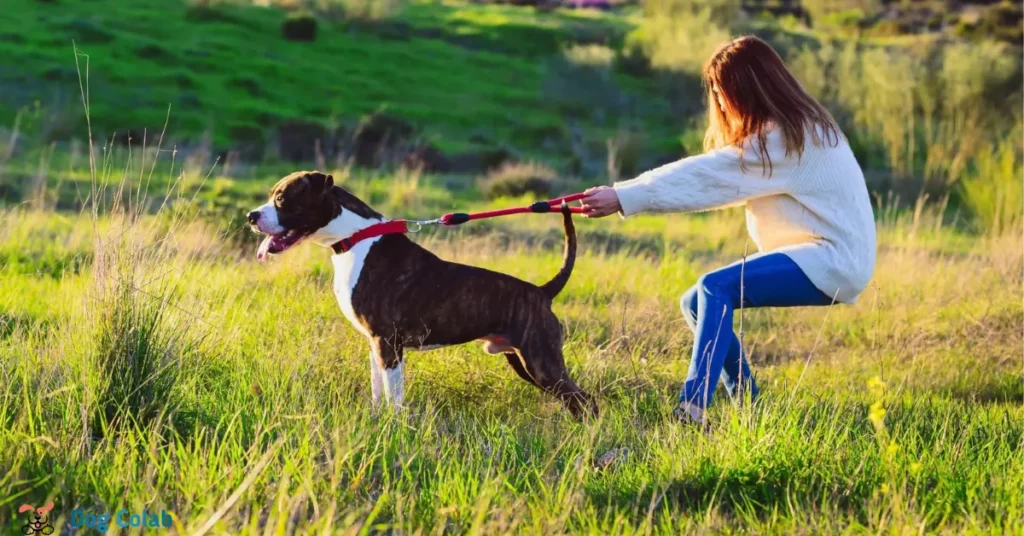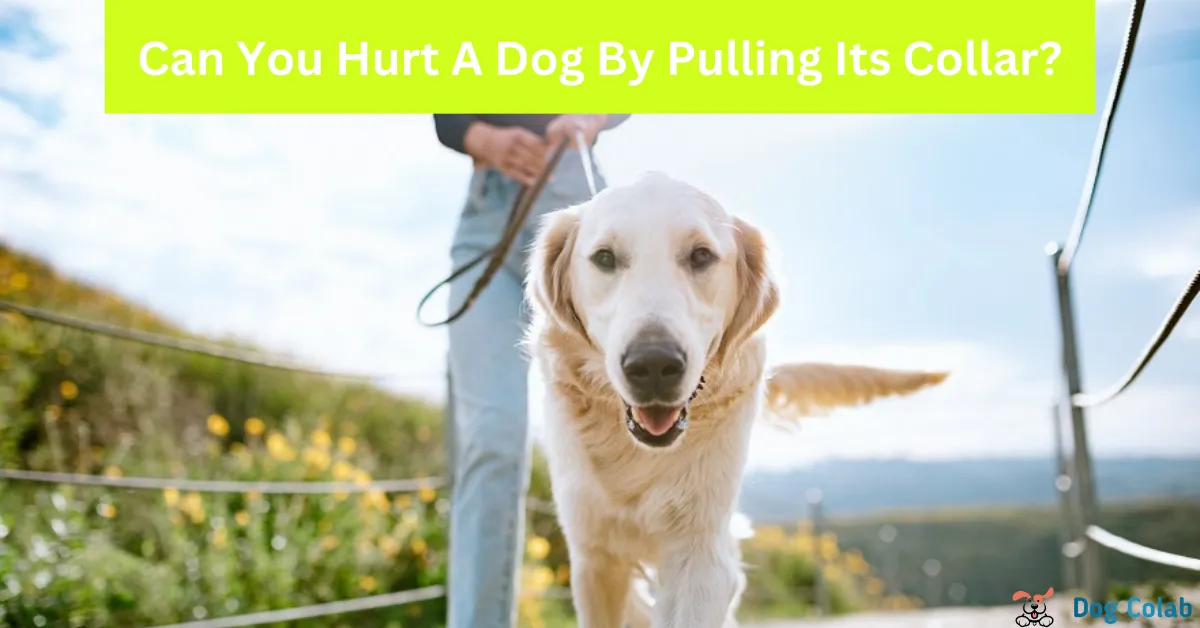Our furry companions hold a special place in our hearts, and as responsible pet owners, it’s crucial to ensure their safety and well-being. Among the various aspects of dog care, the use of collars has garnered attention due to the potential risks associated with pulling on a dog’s collar. So, In this blog post, we will discuss can you hurt a dog by pulling its collar and the effects of collar pulling on canine health and behavior, and how you will stop your dog from pulling on the leash.
Why Does My Dog Pull On the Leash? (8 Reasons)
Leash pulling is a common behavior observed in many dogs during walks, and while it can be frustrating for owners, it’s essential to recognize that there are underlying reasons behind this behavior.

1. Excitement and Exploration
Dogs are naturally curious creatures and walks provide them with opportunities to explore new scents, sights, and sounds. Excitement and the desire to investigate their surroundings can lead to pulling as they strive to get to interesting spots quickly.
2. Lack of Training
Dogs aren’t born knowing how to walk calmly on a leash; it’s a skill that needs to be taught. If a dog has not been properly trained to walk on a leash, it may resort to pulling as a default behavior.
3. Desire for Stimulation
Dogs have a keen sense of smell and are highly attuned to their environment. They may pull on the leash to get closer to a scent, another dog, or an interesting object, driven by their instinct to explore and interact.
4. Social Interaction
Dogs are social animals, and encountering other dogs or people during walks can trigger excitement and a desire to approach them. This can result in pulling as the dog tries to reach the source of their interest.
5. Energy Release
Dogs that don’t receive sufficient physical and mental stimulation can have excess energy that they channel into leash pulling. Pulling may serve as an outlet for their pent-up energy.
6. Lack of Focus
Some dogs are easily distracted by their surroundings, making it difficult for them to maintain focus on walking beside their owner. This lack of focus can contribute to leash pulling.
7. Previous Reinforcement
If a dog has learned that pulling on the leash gets them where they want to go faster, they may continue the behavior. For instance, if a dog pulls and is rewarded with reaching an interesting spot, they learn that pulling yields positive outcomes.
8. Breed and Size
Certain dog breeds are naturally more prone to pulling due to their genetic predispositions. Larger and stronger breeds may inadvertently pull due to their physical power.
Are Dogs Comfortable With Collars?
Whether a dog is comfortable with wearing a collar largely depends on their individual temperament, experiences, and the type of collar used. Many dogs become accustomed to wearing collars from a young age and don’t exhibit any discomfort. However, some dogs may initially find collars unfamiliar or even slightly uncomfortable due to the sensation around their neck.

It’s crucial to introduce collars gradually and positively, associating them with treats, praise, and pleasant experiences. Selecting a well-fitting collar made from comfortable materials can also contribute to a dog’s comfort.
You may also be interested in:– How many collars should a dog have.
Can You Hurt A Dog By Pulling Its Collar?
Yes, pulling on a dog’s collar can potentially hurt or harm the dog, especially if done forcefully or inappropriately. Dogs have sensitive neck structures, including the trachea (windpipe), blood vessels, nerves, and thyroid glands, which can be vulnerable to pressure and strain. Excessive pulling on the collar can cause discomfort, pain, and even physical injuries.

The trachea, in particular, can be at risk of damage, leading to breathing difficulties, choking, and potential long-term health issues. Additionally, repeated collar pulling can have negative psychological effects on a dog, such as fear, anxiety, and aggression.
Is It Ok To Pull A Dog By Its Collar?
Pulling a dog by its collar is generally not recommended and should be avoided whenever possible.

While there might be situations where gentle guidance using a collar is necessary for safety, such as redirecting a dog away from danger, consistently pulling a dog by the collar can lead to various issues.
Recommended Also Read:- Are thicker collars better for dogs.
The Potential Damage Caused By Pulling A Dog Collar
Pulling a dog’s collar can potentially cause various types of damage to the dog’s neck and overall well-being. Here are some potential damages that can you hurt a dog by pulling its collar.

- Physical Discomfort: Dogs have sensitive neck structures, including the trachea (windpipe), blood vessels, nerves, and thyroid gland. Pulling on the collar can cause immediate discomfort, irritation, and even pain to these structures.
- Choking and Breathing Difficulties: Pulling the collar too forcefully can lead to choking and difficulty breathing, as pressure is applied to the trachea. This can result in coughing, wheezing, and respiratory distress.
- Tracheal Damage: Repeated and forceful collar pulling can damage the trachea over time, potentially leading to chronic issues like tracheal collapse. Tracheal collapse is a condition where the tracheal rings weaken and collapse, causing breathing difficulties.
- Thyroid Gland Disruption: The thyroid gland, located in the neck, is responsible for regulating metabolism and overall health. Excessive collar pressure can disrupt its function and potentially lead to health complications.
- Blood Circulation: Collar pressure can affect blood circulation to the head and neck region, leading to reduced oxygen supply and potential discomfort.
- Behavioral Impact: Dogs that experience discomfort or pain from collar pulling may develop negative associations with walks or the collar itself. This can result in behavioral changes, including fear, anxiety, aggression, and can dog hurt neck pulling on leash.
- Psychological Stress: The sensation of choking or discomfort caused by collar pulling can lead to psychological stress and anxiety in dogs, affecting their overall quality of life.
- Long-Term Consequences: Continuous collar pulling can result in cumulative damage over time, leading to chronic health issues and lasting behavioral problems.
Signs of Discomfort and Injury By Pulling A Dog’s Collar and Leash
Pulling a dog’s collar and leash can lead to discomfort and even injury over time. It’s crucial for dog owners to be vigilant and recognize the signs that indicate their dog might be experiencing problems due to collar and leash pulling.

Here are some common signs of discomfort and potential injury.
- Excessive Scratching or Pawing: If a dog is constantly scratching at their collar or pawing at their neck, it could be a sign that the collar is causing irritation or discomfort.
- Coughing and Gagging: Collar pulling can put pressure on the trachea, leading to coughing, gagging, or wheezing. If your dog frequently coughs or makes choking sounds during walks, it’s a clear indication of discomfort.
- Resistance During Leash Walks: If your dog pulls back, refuses to move, or tries to go in a different direction during leash walks, it might be due to discomfort caused by collar pressure.
- Reluctance to Wear the Collar: If your dog shows hesitation or resistance when you try to put the collar on, it could be a sign that they associate it with discomfort or negative experiences.
- Changes in Behavior: Dogs that experience discomfort due to collar pulling might display behavioral changes, such as increased anxiety, fear, or aggression during walks or when the collar is being handled.
- Swelling or Redness: Check for any signs of swelling, redness, or irritation around the neck area, which could indicate that the collar is causing friction or pressure-related issues.
- Voice Changes: Collar pressure can affect the vocal cords, leading to changes in your dog’s voice. If you notice hoarseness or changes in dog barking, it could be a sign of discomfort.
- Avoidance Behavior: Dogs may try to avoid situations that cause discomfort, such as putting their head down, attempting to slip out of the collar, or trying to escape the leash.
- Difficulty Breathing: Severe collar pulling can lead to difficulty breathing and labored breathing, which is a serious concern that requires immediate attention.
If you notice any of these signs in your dog, it’s important to address the issue promptly. Consider using alternative equipment like harnesses or head halters that distribute pressure more evenly, and practice positive reinforcement training techniques to encourage loose leash walking.
Recommended Also Read:- Can prong collars make dog aggressive.
How To Prevent Neck Injuries When Using A Collar On A Dog?
Preventing neck injuries when using a collar on a dog requires careful consideration of the type of collar, proper fit, training, and attentive handling. Here are several steps you can take to minimize the risk of neck injuries.

- Choose the Right Collar: Opt for collars that are specifically designed to be gentle on a dog’s neck, such as flat collars made from soft materials. Avoid using choke chains or prong collars that can apply excessive pressure to the neck.
- Proper Fit: Ensure the collar fits snugly but not too tight. The collar should fit your dog’s neck easily with two fingers between them. Check the fit regularly as your dog grows.
- Use Martingale Collars: Martingale collars, also known as limited-slip collars, are designed to prevent dogs from slipping out of the collar while preventing excessive tightening. They can be a safer option for dogs that tend to pull or back out of collars.
- Limit Collar Use: Reserve collar used for identification and situations where restraint is necessary. If you’re concerned about neck injuries, consider using harnesses or head halters for walks and outings.
- Positive Reinforcement Training: Teach your dog to walk calmly on a leash using positive reinforcement techniques. Reward them for walking beside you on a loose leash rather than pulling. This reduces the likelihood of sudden jerks and pressure on the collar.
- Avoid Leash Jerking: Refrain from jerking the leash to correct your dog’s behavior. Leash jerking can cause sudden pressure on the neck, increasing the risk of injury.
- Frequent Checks: Regularly inspect your dog’s neck for any signs of irritation, redness, or discomfort caused by the collar. Adjust the collar if needed.
- Rotate Collars: Give your dog’s neck a break by rotating between different collars and harnesses. This can help prevent continuous pressure on the same spot.
- Regular Vet Visits: Regular visits to the veterinarian can help identify any neck-related issues early and ensure your dog’s overall health.
- Alternative Equipment: If you’re concerned about neck injuries, consider using harnesses or head halters for leash walks. These options distribute pressure more evenly across the dog’s body, reducing strain on the neck.
Read More:- Get rid of dog collar marks.
How To Stop Your Dog From Pulling On A Leash?
Stopping a dog from pulling on a leash requires consistent training, patience, and the use of effective techniques. Here’s a step-by-step guide to help you teach your dog to walk calmly on a leash,

- Use Proper Equipment: Choose appropriate equipment like a well-fitting harness or head halter. These options distribute pressure more evenly and discourage pulling without causing discomfort.
- Start with Basic Training: Before going on walks, ensure your dog knows basic commands like “sit,” “stay,” and “heel.” This establishes a foundation for good leash manners.
- Practice Inside: Begin training indoors or in a quiet, distraction-free environment. Attach the leash to your dog’s collar or harness and allow them to get used to the sensation without the temptation to pull.
- Use Positive Reinforcement: Reward your dog for walking beside you on a loose leash. Offer treats, praise, and affection as they maintain the desired position.
- Teach the “Heel” Command: Teach your dog the “heel” command, which means walking close to your side. Practice this command with treats to encourage your dog to stay by your side.
- Stop and Go: When your dog starts pulling, stop walking and stand still. Wait until they release the tension on the leash and return to your side. Then, reward and continue walking.
- Change Directions: If your dog pulls, change direction abruptly. This not only interrupts the pulling behavior but also encourages them to pay attention to your movements.
- Stay Calm: Avoid yanking the leash or getting frustrated. Stay calm and composed during training sessions to create a positive learning environment.
- Short Walks: Start with short, focused walks to build your dog’s skills. Gradually increase the duration as they become more comfortable and proficient.
Conclusion “Can You Hurt A Dog By Pulling Its Collar”
Pulling a dog’s collar can indeed cause harm and discomfort to your canine companions. The sensitive structures of their neck, including the trachea, blood vessels, and nerves, are susceptible to damage from excessive pressure.
To prioritize the well-being of your dogs, it’s crucial to employ positive training methods, choose appropriate equipment like harnesses, and ensure responsible handling. By doing so, we can ensure safe and enjoyable experiences for both dogs and their owners during walks and other activities.
NOTE:- More information can be found by clicking this link.
FAQs
1. What happens if you pull a dog’s collar too hard?
Excessive pulling on a dog’s collar can lead to immediate injuries to the trachea and neck, and can also cause hidden damage to nerves, vertebrae, and organs, risking long-term harm.
2. How strong are dogs necks?
Dogs have strong necks inherited from their wolf ancestors, capable of supporting sprinting, endurance, and even dragging large prey to the ground.
3. How do I know if my dog has a neck injury?
If your dog displays symptoms like lowered head, stiff neck, muscle spasms, reluctance to move, whining, yelping, and difficulty with everyday activities, it may have a neck injury.
4. Does taking a dogs collar off feel good?
Yes, removing a dog’s collar can feel good for them. It allows their skin to breathe, prevents potential skin issues, and reduces choking hazards from crate wires and tags.

